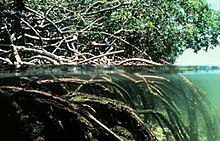Mangrove (tree)
Mangrove trees are lignifying salt plants from different families of the Bedecktsamer . Their common feature is that they have adapted to life in the tidal area of tropical coastal regions and are only there forming populations.
ecology
Adjustments

The special adaptations of the mangrove trees to their habitat include pronounced salt tolerance and the ability to take root in low-oxygen and often unstable sediment. Often stilt or buttress roots and differently shaped pneumatophores with aerenchyma are formed. Some taxa have leaves with salt glands ( Aegiceras , Aegialitis and Avicennia ).
In many cases, it is characteristic of the fact that it spreads via fruits that have developed very well at the moment of separation from the mother tree and that develop into a buoyant seedling in a very short time. The mangrove trees from the Rhizophoraceae family spread "viviparous" via young plants that have already germinated on the mother tree ( viviparia ).
Different mangrove tree species develop dwarf forms under unfavorable environmental conditions (hypersaline or nutrient-limited locations).
Diversity and Limits of Distribution
The reasons for the species poverty of the West African-American mangrove flora in comparison with the mangrove forests of the Indo-Pacific region have not yet been clarified .
The natural limit of distribution is only indirectly related to a cool climate. The decisive factor is the water temperature during the cool months. In general, a winter isotherm in the water below 20 ° C is lethal for many mangrove species.
use
Mangrove trees can be used for forestry in exceptional cases ( Malaysia ). Mangrove wood is used for charcoal production or directly as firewood and occasionally for simple wooden structures. The tannin-containing bark of some mangrove trees is used regionally for the extraction of tannins .
For the importance of mangrove forests in coastal protection see Mangrove (ecosystem) .
Systematics

Mangrove trees do not form a systematically uniform group, but belong to different families of flowering plants (Magnoliophyta).
Important taxa :
-
Avicennia is the only genus in the subfamily Avicennioideae within the acanthus family (Acanthaceae)
- Black Mangrove ( Avicennia germinans )
- about ten other species
-
Rhizophora belongs to the family of the Rhizophoragewächse (Rhizophoraceae, Tribus Rhizophoreae )
- Red Mangrove ( Rhizophora mangle )
- five more types
The common name "white mangrove" is used in two ways:
- Mostly, "White Mangrove" means Laguncularia racemosa , the only species of the genus Laguncularia in the winged family (Combretaceae)
- Avicennia marina is less common (this species is also known as "gray mangrove")
Other genera / species:
- The button mangrove ( Conocarpus erectus ) belongs to the winged family (Combretaceae).
- Lumnitzera also belongs to the winged family (Combretaceae).
- Bruguiera , Ceriops and Kandelia belong (like Rhizophora , see above) to the tribe Rhizophoreae within the family of the Rhizophoraceae.
- Sonneratia belongs to the loosestrife family (Lythraceae).
- Aegiceras belongs to the myrsin family(Myrsinaceae).
- Excoecaria belongs to the milkweed family(Euphorbiaceae).
- Heritiera belongs to the subfamily of sterculioideae (Sterculioideae) within the mallow (Malvaceae).
- The nipa palm ( Nypa fruticans ) belongs to the palm family (Arecaceae).
- Pelliciera belongs to the Tetrameristaceae family.
- Xylocarpus belongs to the mahogany family(Meliaceae).
literature
- Philip B. Tomlinson: The Botany of Mangroves. Cambridge University Press, Cambridge et al. 1986, ISBN 0-521-25567-8 (English).
Web links
- In English
- [1] Mangrove Management of the UN Food & Agriculture Organization
- [2] UN Food & Agriculture Organization web page on the status of the expansion of mangrove areas
- www.mangrove.or.jp International Society for Mangrove Ecosystems
- www.glomis.com GLOMIS: Global Mangrove Database and Information System
- www.madeinnys.com/mangrove/mangroves.htm Information about the mangroves of Kenya



